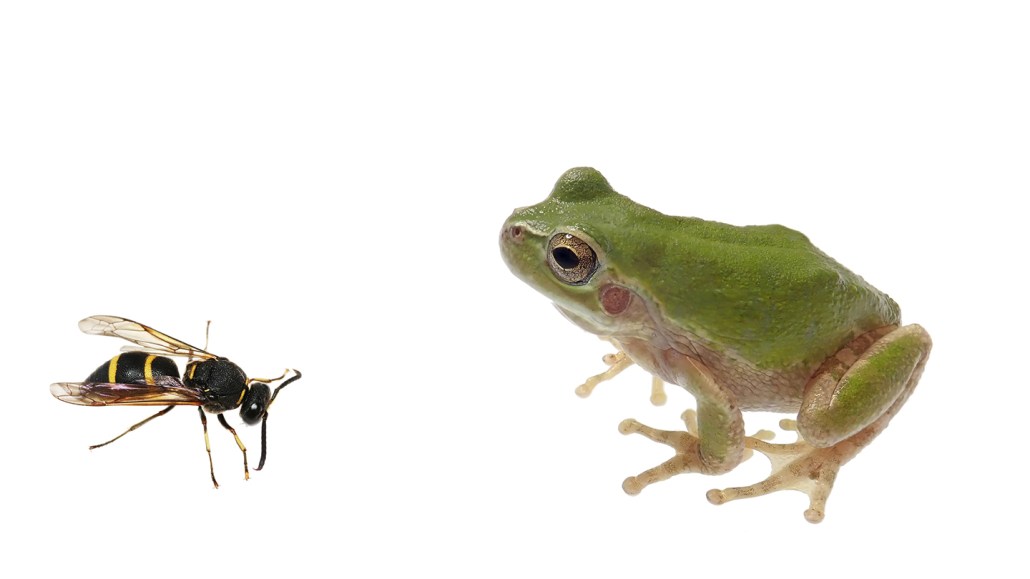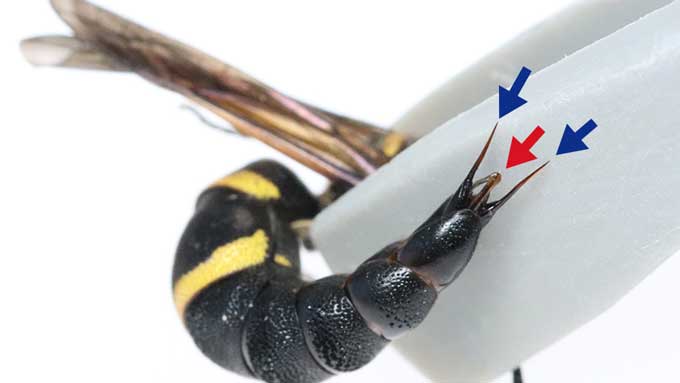
The genital spikes of this Anterhynchium mason wasp give him a fighting chance of survival if a dangerous tree frog attacks.
Shinji Sugiura
Fending off an attacker by swordplay with two genital spines turns out to be a moderately useful form of self-defense for male wasps, an unusual study shows. A mason wasp’s rear spikes may be useless when it comes to delivering sperm, but they could save his life.
Male wasps (and bees) don’t grow venom-injecting stingers. That’s female weaponry that evolved with the equipment for laying eggs. Instead, males of a mason wasp species fight against gulping tree frogs (and collecting entomologists) by deploying a pair of spines that evolved with male reproductive genital equipment at the wasp’s rear.
The spines are just pseudo-stings. There’s no venom, but a male wasp can stab an attacking frog in the face and mouth.
“Our study is the first to demonstrate the defensive roles of pseudo-stings as counterattack devices in wasps,” says ecologist Shinji Sugiura of Kobe University in Japan. Biologists have long known the spines exist, but the new study, published December 19 in Current Biology, tests how well they work.
The inspiration came from Sugiura’s student and coauthor, Misaki Tsujii, who got jabbed while collecting a male Anterhynchium gibbifrons mason wasp.
Female mason wasps use their real stinging equipment to paralyze multiple caterpillars as still-alive and fresh baby food. A mom seals zombified caterpillars into the private nursery chamber she builds for each offspring.
Males, without true stinging power, can still deliver “a pricking pain,” says Sugiura. To see just how much protection that pricking offered, the researchers put the wasps near various hungry frogs in the lab.
Each of 17 male wasps trapped with a pond frog (Pelophylax nigromaculatus) got eaten despite the pricking. Confrontations with the tree frog Dryophytes japonica, however, were a different story.
Male wasps resisted, and this time with some success. Their genital spines “were frequently observed to pierce the frog mouth,” the researchers report. Lab video shows a tree frog batting its skinny-toed feet against a wasp it was vigorously spitting out of its wide frog mouth. Frogs ultimately rejected six of 17 wasps. When offered wasps with the spines removed, however, the tree frogs ate them all.
Judging by Tsujii’s own reaction to being pseudo-stung by one of these male wasps, they don’t sound like pleasant snacks. She ranks the pain as a 1 on the 0–4 Schmidt pain scale used to categorize sting agony increasing from none to, non-technically, chained in hot lava (SN: 7/24/16). A honeybee delivers a 2 of stinging pain.
“I can attest from personal experience that male pseudo-stings … are used in defense,” says James Carpenter, a wasp specialist at the American Museum of Natural History in New York City. “I’ve been jabbed by them several times, and they can be painful enough that they elicit a startle response and you drop the wasp.”
Despite the rear position, though, “the spines don’t appear to be used in copulation,” Carpenter says. On such occasions, “they’re moved out of the way.”

Sugiura and Tsujii even checked to see if a male that a female had rejected in courtship would use his spines in some way to overcome her objection. No, the researchers say after watching 10 matings and seven rejections: The spines in this species appear merely defensive.
The male spikes, called parameral spines, show up in other kinds of wasps too but have not been tested in those species for defensive power. And the possibility that the spines still have some sexual function should be considered, says Menno Schilthuizen, an evolutionary ecologist at the Naturalis Biodiversity Center and Leiden University in the Netherlands.
“The male genitalia of many insects have such accessory spines, whip or drumstick-like structures,” he says. Remaining “outside of the female’s body during copulation … does not mean that they do not play a role in reproduction. In many species they tap or stroke the female’s abdomen in what’s known as ‘copulatory courtship,’ enhancing the male’s chances that the female will actually use his sperm for fertilizing her eggs.”
Few studies, even in nonwasps, have documented genital action for self-defense. The other example Sugiura and Tsujii cite comes from hawkmoths. These big, night-flying foragers use a genital structure to create scratchy static that jams the echolocation frequencies of moth-hunting bats (SN: 7/3/13).
Studying genital structures in terms of defense instead of just sexual allure is important, the researchers argue, in large part because it’s not common. Looking for death-dodging aspects of genital evolution could encourage “a new perspective,” the researchers propose. And there’s astonishing variety to account for in the evolution of genital forms.






